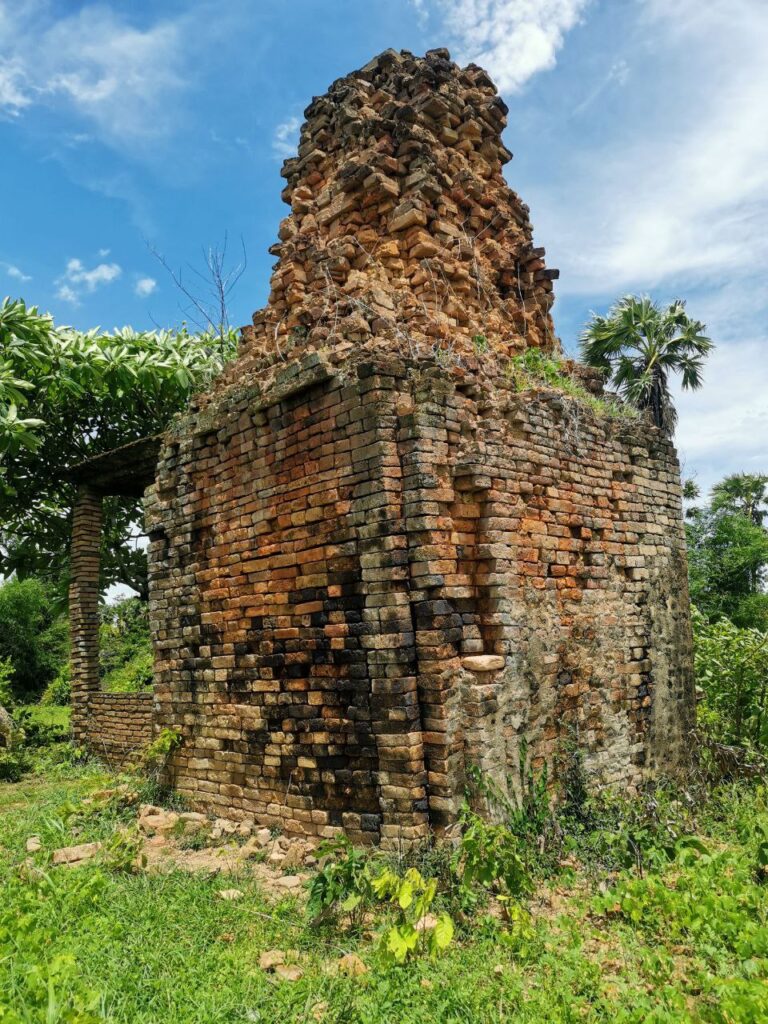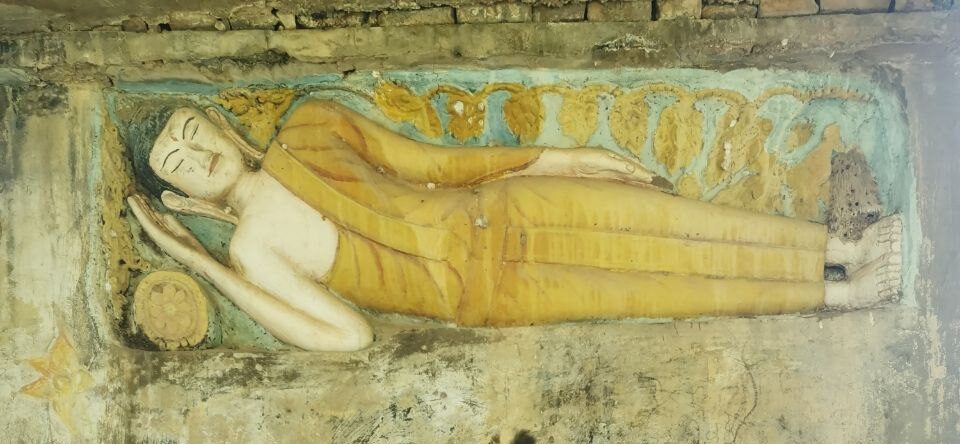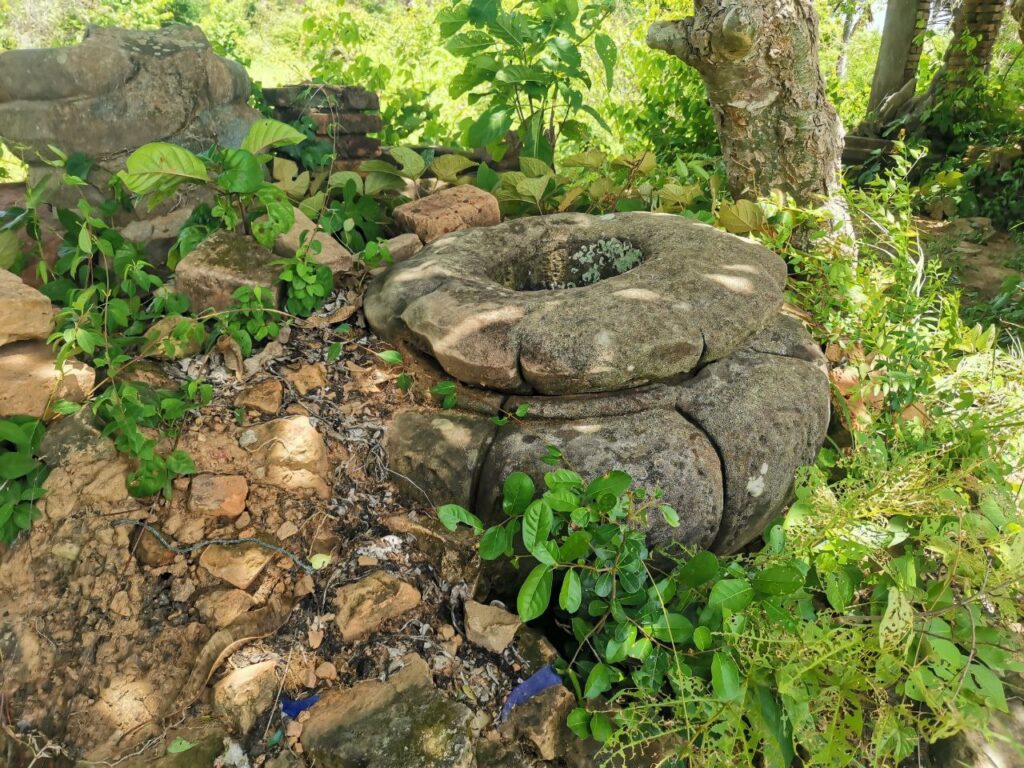ប្រាសាទបន្ទាយស្ទោង មានទីតាំងស្ថិតនៅភូមិបន្ទាយស្ទោង ឃុំបន្ទាយស្ទោង ស្រុកស្ទោង ខេត្តកំពង់ធំ ដែលមានចម្ងាយប្រមាណ ៥៦ គ.ម. ភាគខាងលិចទីរួមខេត្តកំពង់ធំ និងមានចម្ងាយប្រមាណ ៨ គ.ម. ពីទីប្រជុំជនស្រុកស្ទោង។ ឈ្មោះ “បន្ទាយស្ទោង” នេះ អ្នកស្រុកហៅសំដៅលើប្រាសាទផង និងសំដៅដល់ឈ្មោះទីតាំងស្ថាននាមជាភូមិនិងឃុំផង។ “បន្ទាយ” មានន័យដើមថា “កំពែង” ពោល គឺសំដៅលើសំណង់ជាដី ឥដ្ឋ ឬថ្ម ដែលព័ទ្ធជុំវិញ ឬខ្លះមានគូទឹកជុំវិញ។ រីឯ “ស្ទោង” ទំនងក្លាយមកពីពាក្យបុរាណថា “ចទោង” ហើយត្រូវនឹងពាក្យឬសប្រើដល់សព្វថ្ងៃថា “ទោង” ដែលអាចសំដៅលើរូបរាងដែលកោង បត់បែន ពត់ពែន ដូចគេយោលទោងដូច្នោះដែរ។ ម្ល៉ោះហើយ ការដែលអ្នកស្រុកហៅប្រាសាទនេះថា “បន្ទាយស្ទោង” ទំនងគេសំដៅលើកំពែងប្រាសាទដែលធ្វើអំពីឥដ្ឋមានរាងកោង ឬរាងដូចទឹករលក។ តែសព្វថ្ងៃ កំពែងប្រាសាទដែលធ្វើអំពីឥដ្ឋរបស់ប្រាសាទនេះ បានកប់ក្នុងដីមើលស្ទើរតែលែងយល់ទៅហើយ។
កន្លងមកប្រាសាទនេះពុំសូវមានអ្នកសិក្សាចាប់អារម្មណ៍ច្រើនឡើយ តែក៏នៅតែមានអ្នកធ្លាប់មកសិក្សាតាំងពីរវាងដើមស.វ.ទី២០ ហើយអ្នកស្រាវជ្រាវទាំងនោះមានដូច លោក Lunet De Lajonquière ឆ្នាំ១៩០២ លោក Henri Parmentier ឆ្នាំ១៩១៣ លោក M. Dufosse ឆ្នាំ១៩១៨ លោក Robert Dalet ឆ្នាំ១៩៣៦ ។ល។ ប៉ុន្តែ ការសិក្សាទាំងអម្បាលម៉ាន រៀបរាប់សង្ខេបតិចបំផុត ពោល គឺអាចរាប់បានថាជាបញ្ជីសារពើភណ្ឌតែប៉ុណ្ណោះ។


ប្រាសាទបន្ទាយស្ទោង សាងសង់ឡើងអំពីឥដ្ឋ មានរាងបួនជ្រុងស្មើ មានកំពែងឥដ្ឋព័ទ្ធជុំវិញ ហើយបែរមុខទៅទិសខាងកើត ពោល គឺបែរមុខឆ្ពោះទៅរកស្ទឹងស្ទោងដែលនៅក្បែរប្រាសាទតែម្តង។ ប្រាសាទនេះ នៅសល់រូបរាងច្រើនគួរសម តែគួរឱ្យសោកស្តាយដែលជញ្ជាំងទាំងមូលនៃប្រាសាទ អ្នកស្រុកបានយកឥដ្ឋចាស់មកបិតបន្ថែមសារជាថ្មី ធ្វើឱ្យយើងមានភាពពិបាកនឹងកំណត់រូបរាងដើមនៃប្រាសាទ ហើយក្រៅពីនេះគេបានយកឥដ្ឋចាស់លាយជាមួយឥដ្ឋថ្មី សាងជាសសរនិងរោងលយមកខាងមុខទៀតផង។ រីឯផ្នែកដំបូលវិញ គឺមានរលុះឥដ្ឋធ្លាក់មកក្រោមយ៉ាងច្រើន រួមទាំងធ្លាក់ដំបូលរាងដូចផ្កាឈូកធ្វើអំពីថ្មភក់មកក្រោមផង។ នៅក្នុងការសិក្សារបស់លោក Lunet De Lajonquière បានរៀបរាប់ថា នៅច្រកខាងកើតមានផ្តែរទ្វារព្រះឥន្រ្ទគង់លើដំរីក្បាលបី ប៉ុន្តែសព្វថ្ងៃផ្តែរទ្វារនេះបានបាត់បង់ទៅហើយ និងអ្នកស្រុកជំនួសវិញដោយរូបចម្លាក់ផ្តែរសម័យថ្មីជាព្រះពុទ្ធរូប និងបន្ថែមហោជាងជារូបព្រះពុទ្ធចូលបរិនិព្វាន។ ចំណុចនេះសបញ្ជាក់អំពីការវិវត្តនៃសាសនាក្នុងរបត់ថ្មី លើសំណង់ចាស់ដដែល ពោល គឺការវិវត្តជំនឿពីព្រហ្មញ្ញសាសនាមកជាព្រះពុទ្ធសាសនាថេរវាទ។



ក្រៅអំពីប្រាសាទ យើងអាចឃើញបំណែកវត្ថុសិល្បៈធ្វើអំពីថ្មភក់នៅសម័យបុរាណជាច្រើនដែលគេយកមកទុកនៅរាយប៉ាយមុខប្រាសាទ។ វត្ថុទាំងនេះ ទំនងគេយកមកពីទួលប្រាសាទបុរាណនៅជុំវិញប្រាសាទបន្ទាយស្ទោង ហើយយកមកទុកនៅទីនេះយូរមកហើយ។ ពោល គឺមានលក្ខណៈដូចនៅប្រាសាទព្រះធាតុរកាក្នុងសង្កាត់ស្រយ៉ូវ ក្រុងស្ទឹងសែន ឯណោះដែរ ដែលមានន័យថា អ្នកស្រុកនៅតែគិតថា វត្ថុទាំងអស់ដែលជារបស់បុរាណសុទ្ធសឹងតែមានវិញ្ញាណនិងជារបស់ដែលជាទីគោរពប្រណិប័តន៍យ៉ាងខ្ជាប់ខ្ជួន។ វត្ថុសិល្បៈទាំងនេះ មានខ្លះជាវត្ថុសិល្បៈសម័យមុនអង្គរ ជាក់ស្តែងដូចជា បំណែកសសរពេជ្រជាដើម ហើយក្រៅពីនេះមានជើងទម្រ កំពូលប្រាសាទ បំណែកចម្រឹងបង្អួច បំណែកព្រះពុទ្ធប្រក់នាគ បំណែកបដិមា។ល។ ជាវត្ថុសិល្បៈនៅសម័យអង្គរចាប់ពីស.វ.ទី១០ ដល់ស.វ.ទី១៣។
អ្វីគួរកត់សម្គាល់បន្ថែម នៅមិនឆ្ងាយប៉ុន្មានពីប្រាសាទបន្ទាយស្ទោង មានស្ថានីយបុរាណជាច្រើនដែលសុទ្ធសឹងជាទីតាំងប្រាសាទបុរាណដែលបាក់បែកក្លាយជាទួល ក្នុងនោះមានដូចជា ទួលយាយទែត ទួលវត្តចាស់ ទួលអ្នកតាពុទ្ធិវង្ស ទួលប្រាសាទដូនប៉េង។ល។ ហេតុដូច្នេះហើយសំណង់បុរាណនៅបន្ទាយស្ទោង និងទីតាំងបុរាណដែលរៀបរាប់នេះ ប្រាកដជាមានទំនាក់ទំនងនឹងគ្នាជាក់មិនខាន ហើយអាចឱ្យយើងសន្និដ្ឋានបានថា ទីតាំងនៅម្តុំប្រាសាទបន្ទាយស្ទោង គឺជាទីប្រជុំជនមួយដ៏សំខាន់តាំងពីសម័យអង្គរមកម្ល៉េះ។
ដោយហេតុថា ប្រាសាទបន្ទាយស្ទោង មិនមានសេសសល់នូវសិលាចារឹក និងគ្រឿងលម្អជាប់នឹងប្រាសាទដែលអាចឱ្យយើងកត់សម្គាល់ជាធំដុំនោះ យើងមានការពិបាកក្នុងការកំណត់អាយុកាលរបស់ប្រាសាទ។ ប៉ុន្តែ បើយើងក្រឡេកមើលផ្នែកស្ថាបត្យកម្ម និងបំណែកវត្ថុសិល្បៈដែលនៅរាយប៉ាយខាងមុខប្រាសាទ យើងអាចទាញសេចក្តីសន្និដ្ឋានបឋមបានថា បន្ទាយស្ទោង ទំនងជាប្រាសាទកសាងឡើងដើម្បីឧទ្ទិសដល់ព្រហ្មញ្ញសាសនា ឬព្រះពុទ្ធសាសនា នៅសម័យអង្គរ ក្នុងរវាងស.វ.ទី១០ ពោល គឺអាចចន្លោះពីរជ្ជកាលព្រះហស៌វរ្ម័នទី១ (គ.ស.៩១០-៩២២) ដល់រជ្ជកាលព្រះបាទជ័យវរ្ម័នទី៥ (គ.ស.៩៦៨ – ១០០០)។ សំណង់ប្រាសាទបន្ទាយស្ទោងទៀតសោត គឺជាស្ថាបត្យកម្មសាសនាមួយក្នុងចំណោមសំណង់ប្រាសាទជាច្រើន ដែលបានតាំងទីនៅតាមបណ្តោយស្ទឹងស្ទោង ជាក់ស្តែង ប្រាសាទអំបែងនំ ប្រាសាទត្រពាំងព្រីង ប្រាសាទតាឡោកប្រាសាទវត្តព្រះដំរី ប្រាសាទវត្តក្តីដើម ។ល។
—————————
Banteay Stoung Temple
Banteay Stoung Temple is located in Banteay Stoung Village, Banteay Stoung Commune, Stoung District, Kampong Thom Province, approximately 56 km from the west of Kampong Thom provincial. The name “Banteay Stoung” refers to both the temple and the location as a village and commune. “Fortress or Banteay” originally means “rampart”, meaning a brick or stone structure is surrounded and also sometimes contains moats. “Stoung” seems to be derived from the ancient word “Chtong” and corresponds to the word used today “Tong”, which can refer to the shape of the curve. Therefore, the locals call this temple “Banteay Stoung” which probably refers to the rampart of the temple made of brick, curved or shaped like waves. But today, the brick rampart of the temple is buried in the ground, almost incomprehensible.
In the past, the temple has not attracted researchers. However, in the early 20th century there are researchers such as Mr. Lunet De Lajonquière in 1902, Mr. Henri Parmentier in 1913, Mr. M. Dufosse in 1918, Mr. Robert Dalet in 1936, etc. But the study is very brief, that is, it can only be counted as an inventory list.
Banteay Stoung temple is built of brick, has a square shape, is surrounded by a brick rampart, and faces east towards Stoung River. The temple still has a lot of appearances, but sadly, the whole wall of the temple, the locals have added old bricks, making it difficult for us to determine the original appearance of the temple. In addition, old bricks were mixed with new bricks to build columns and sheds in front. As for the roof, there are a lot of bricks falling down, including a lotus-shaped roof made of sandstone. In Lunet De Lajonquière’s study, it is mentioned that at the east gate, there is a gate of Indra sitting on a three-headed elephant, but now the gate has disappeared and the locals have replaced it with a modern statue of Buddha and added the pediment with the Buddha to Nirvana. This point confirms the evolution of religion in a new twist on the same old structure, namely the evolution of beliefs from Hinduism to Theravada Buddhism.
In addition to the temple, we can see many ancient sandstone artifacts scattered in front of the temple. These artifacts are likely taken from the ancient temples around Banteay Stoung and have been kept here for a long time. That is, it is similar to the Preah Theat Roka temple in Srayov commune, Stung Sen city, which means that the locals still think that all the antiquities are spirit and are firmly worshiped. Some of these artifacts are pre-Angkorian period, such as pieces of colonnettes, etc. Besides, there are pedestals, the rooftop of the temple, the window sills, the Buddha on Naga, the statues, etc, which are in the Angkorian period from the 10th century to the 13th century.
Remarkably, not far from Banteay Stoung temple, there are many ancient sites, all of which are ancient temple sites that completely collapsed, such as Tuol Yeay Tet, Tuol Wat Chas, Tuol Neak Ta Puthivong, Tuol Prasat Daun Peng, etc. Therefore, the ancient buildings in Banteay Stoung and the ancient sites mentioned here are definitely related and we can conclude that the location around the temple of Banteay Stoung is an important downtown since the Angkorian period.
This temple is difficult to determine the age because it does not have any inscriptions and ornaments attached to the temple. However, if we look at the architecture and fragments of artifacts scattered in front of the temple, we can conclude that Banteay Stoung was probably a temple dedicated to Brahmanism or Buddhism in the Angkorian period during the 10th century. That is, between the reign of King Hasavarman I (910-922 AD) to the reign of King Jayavarman V (968-1000 AD). The construction of the Banteay Stoung temple is one of the many religious structures located along the Stung River, which is similar to the Ambeng Nom temple, Trapeang Pring temple, Ta Laok temple, Wat Preah Damrei temple, Wat Kdei Deum temple, etc.
អត្ថបទដោយ៖ លោក ម៉ង់ វ៉ាលី






